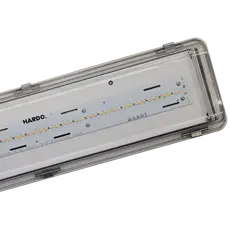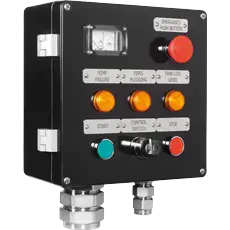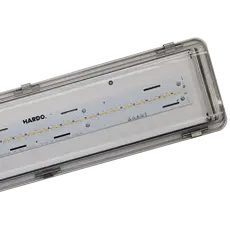Ex e flameproof enclosure: design, advantages, limitations


Explosion-proof protection type Ex e is defined in the international standard IEC EN 60079-7. Below, we explain the principle behind it, show example applications, and provide some useful tips for users and purchasers of Ex equipment.
Ex e protection refers to enhanced safety, or reinforced construction. It is one of the most popular protections used in devices designed to operate in gas hazardous areas. You can find it, for example, in devices such as:

- lighting fixtures,
- switches/safety switches,
- junction boxes,
- control panels,
- electrical switchboards,
- cable glands,
- sensors and detectors,
- motors.
Ex e protection is intended for use in hazardous areas zones 1 and 2, i.e., atmospheres generated by the presence of flammable gases and vapors. It is not used in gas zone 0 or in dust zones 20, 21, and 22.
Operating principle of Ex e protection
This protection concept allows for the possibility of an explosive atmosphere appearing inside the enclosure, which distinguishes it from, among others, Ex m (protection by encapsulation) or Ex p (protection by pressurized enclosure). At the same time, unlike Ex d protection, reinforced construction Ex e devices are not resistant to the pressure of an explosion inside them.
What is Ex e protection all about?
The Ex e protection concept involves reducing the likelihood of ignition sources (e.g., temperature, sparks, electric arcs) occurring on both the device’s enclosure surface and inside it. This task is primarily accomplished by:
- ensuring that the temperature on the surface of components mounted inside the device and on the device’s enclosure does not exceed the ignition temperature of the explosive atmosphere in which the device will be installed. This must be confirmed through thermal calculations that consider the electrical parameters of the components used in the device (depending on the device, these may include connectors, switches, indicator lights, ammeters, voltmeters, wires, control components, etc.),
- reducing the risk of electric arcs, sparking, and temperature by ensuring secure electrical connections, grounding, properly selected electrical insulation materials, and appropriate clearance and creepage distances according to EN PN 60079-14 (clearance: the shortest distance between two conductive elements or between a conductive element and the device’s limiting surface measured in air; creepage distance: the distance between two conductors along an insulating surface. The creepage distance must be greater than or equal to the clearance),
- reducing the risk of ignition sources inside the enclosure by using explosion-proof components (components with a different type of protection than Ex e, e.g., an electronic component with Ex m protection (encapsulation) can be installed inside an Ex e enclosure – more information on this can be found in the section: Mixed construction devices);
- using explosion-proof cable glands (Ex e or Ex d glands may be used in an Ex e enclosure),
- reducing the risk of enclosure damage through appropriate material execution in accordance with PN EN 60079-0.
Ex e protection levels
The same type of explosion-proof protection can provide different levels of safety, which are defined in the PN EN 60079-14 standard. Below you will find a table with these levels and their reference to the equipment category and the hazardous area in which the equipment can be used.
| EPL Designation | Protection Level | Equipment Category (ATEX) | Hazardous Area |
|---|---|---|---|
| Ga/Da | Very high | 1G/1D | 0/20 |
| Gb/Db | High | 2G/2D | 1/21 |
| Gc/Dc | Increased | 3G/3D | 2/22 |
G – gases. D – dusts.
It is worth noting that Ex e devices are only available in Gb and Gc versions, meaning they are intended for use in hazardous areas zones 1 and 2 (gases and vapors).
What about other hazardous areas?
Zone 0: If we look at the list of devices for which Ex e protection is used, we quickly conclude that they are almost never used in Zone 0, i.e., in a tank where a gaseous explosive atmosphere is constantly present. How often in such conditions do we need to use a control panel or motor?
Dust zones 20, 21, 22: However, to use a device in dust hazardous areas (20, 21, 22), another type of protection, such as Ex t, can be used, which is a kind of equivalent to Ex e protection in gas zones. What the designation of a device with both types of protection looks like is shown below on the example of an explosion-proof lighting fixture.
Historically, Ex e devices often compete with Ex d devices. Each of these solutions has its advantages, with reinforced construction devices being the more versatile solution. Let’s compare both types of protection:
| Ex e | Ex d | |
|---|---|---|
| Purchase costs | 🟢 | 🔴 |
| Operating costs | 🟢 | 🔴 |
| Protection reliability | 🟢 | 🔴 |
| Weight | 🟢 | 🔴 |
| Use in Zone 0 | 🔴 | 🔴 |
| Ease and frequency of service | 🟢 | 🔴 |
The data in the table above is an average, so before purchasing, you should conduct an independent analysis of the pros and cons.
Example of explosion-proof feature
Below are some examples with explanations. Here we will focus only on aspects related to the explosion-proof protections used in the device.

Example 1 – Explosion-proof OptiLine Lighting Fixture – Basic Version
| Explosion-proof feature | II 3 G Ex ec IIC T4 Gc |
- Gc – where G means suitability for use in gas hazardous areas, and c indicates an increased level of protection.
- Ex ec – where Ex e indicates protection through reinforced construction, and c reiterates the increased level of protection.
In this case, the situation is quite simple as we are dealing with a device that only has one type of explosion-proof protection (Ex e) at the c level (for use in zone 2). This protection applies to the fixture’s housing, inside which Ex components must be used.
Ex e protection can be combined with other protections in a single device. However, in this case, the explosion-proof feature does not indicate the use of other types of protections, suggesting that both the device housing and the internal components (buttons, ammeters, cable glands, connectors, etc.) have Ex e protection.

Example 2 – HARDO Explosion-proof Control Panel
| Explosion-proof feature | II 2 G Ex db eb mb IIB T4 Gb |
- Gb – where G means suitability for use in gas hazardous areas, and b indicates a high level of protection.
- Ex db eb mb– where Ex e indicates protection through reinforced construction, and b reiterates the high level of protection.
- Ex db ebmb– where Ex d indicates protection through flameproof enclosure, and b reiterates the high level of protection.
- Ex dbeb mb – where Ex m indicates protection by encapsulation, and b reiterates the high level of protection.
In this example, we had as many as three types of protections, so how did we know that Ex e protection referred to the lighting fixture’s housing (body + cover) while Ex d and Ex m protections referred to internal components?
To independently, i.e., without the involvement of the manufacturer or supplier, solve this puzzle, we need to know the types of explosion-proof protections used and have practical experience.
Let’s analyze this situation.
In this case, we are dealing with a control panel, which typically uses components with moving parts (e.g., buttons), eliminating the possibility of completely filling the interior of such a device with encapsulating material. Therefore, we infer that Ex m protection does not apply to the panel’s housing.
Let’s move on.
Ex d protection assumes that non-Ex components can be used inside the device, so using Ex e components there makes neither technical nor economic sense. Therefore, Ex d protection does not apply to the panel’s housing.
Based on the above analysis, we can say with a high degree of certainty that we are dealing with a reinforced construction device Ex e, inside which Ex m and Ex d components are installed.

Example 3 – Explosion-proof OptiLine Fixture – Emergency Version
| Explosion-proof feature | II 3 G Ex ec mc IIC T4 Gc |
- Ex ec mc – where Ex e indicates protection through reinforced construction, and c reiterates the increased level of protection.
- Ex ec mc – where Ex m indicates protection by encapsulation, and c reiterates the increased level of protection.
- Gc – where G means suitability for use in gas hazardous areas, and c indicates an increased level of protection.
As we mentioned earlier, Ex e devices can use components with other types of protections, creating mixed construction devices. For example, the HARDO OptiLine emergency lighting fixture has Ex e protection, which applies to its housing. Inside, there is a component with Ex m protection (protection by encapsulation).
It is worth noting here that another notation for this feature is also allowed:
II 3 G Ex em IIC T4 Gc
As you can see, this time the letters symbolizing the type of explosion-proof protection are not accompanied by information about its level. We obtain this knowledge in this case from the Gc designation.
If you also want to learn how to understand the remaining components of the feature, check out the article: Ex Markings: How to Correctly Select Equipment for Hazardous Areas [Guide + Tasks]
Important information if you are purchasing ex equipment
As a client, you should require the manufacturer to properly execute Ex devices. However, it is your responsibility to provide the complete set of the following information:
- the hazardous area, in which the device will be installed,
- the temperature class of the substance that may form an explosive atmosphere in the hazardous area where the device will be installed (based on this, you will determine the possible temperature class of the device – how to do this … article on selection…),
- maximum surface temperature in the case of atmospheres formed by dust, calculated based on the ignition temperatures of the dust layer and cloud that may form an explosive atmosphere in the hazardous area where the device will be installed,
- the explosion subgroup of gas/vapor/dust forming the explosive atmosphere,
- the quantity, type, and electrical operating parameters of components in the case of devices created according to specifications (e.g., control panels or junction boxes),
- workplace – underground mines/other industrial facilities,
- operating parameters (temperature, corrosion-increasing factors, dust, humidity, UV exposure, other factors important from the user’s point of view).